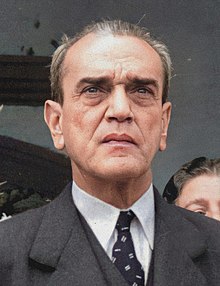Our website is made possible by displaying online advertisements to our visitors.
Please consider supporting us by disabling your ad blocker.
Adolfo Ruiz Cortines
Adolfo Ruiz Cortines | |
|---|---|
 Ruiz Cortines, c. 1952-1958 | |
| 54th President of Mexico | |
| In office 1 December 1952 – 30 November 1958 | |
| Preceded by | Miguel Alemán Valdés |
| Succeeded by | Adolfo López Mateos |
| Secretary of the Interior | |
| In office 30 June 1948 – 30 October 1951 | |
| President | Miguel Alemán Valdés |
| Preceded by | Ernesto P. Uruchurtu |
| Succeeded by | Ernesto P. Uruchurtu |
| Governor of Veracruz | |
| In office 1 December 1944 – 30 June 1948 | |
| Preceded by | Jorge Cerdán Lara |
| Succeeded by | Ángel Carvajal Bernal |
| Member of the Chamber of Deputies for Veracruz′s 3rd district | |
| In office 1 September 1937 – 9 September 1937 | |
| Preceded by | Óscar Fano Viniegra |
| Succeeded by | Antonio Pulido |
| Personal details | |
| Born | Adolfo Tomás Ruiz Cortines 30 December 1889 Veracruz, Veracruz, Mexico |
| Died | 3 December 1973 (aged 83) Veracruz, Veracruz, Mexico |
| Cause of death | Heart failure |
| Political party | Institutional Revolutionary Party |
| Spouses | |
| Military service | |
| Branch/service | |
| Unit | Revolutionary Forces |
Adolfo Tomás Ruiz Cortines[1] (Spanish pronunciation: [aˈðolfo ˈrwis koɾˈtines] ⓘ 30 December 1889 – 3 December 1973) was a Mexican politician who served as President of Mexico from 1952 to 1958. A member of the Institutional Revolutionary Party (PRI), he previously served as Governor of Veracruz and Secretary of the Interior. During his presidency, which constituted the Mexican Miracle, women gained the right to vote, and he instigated numerous public health, education, infrastructure, and works projects.
A member of the Constitutional Army, Ruiz Cortines was the last Mexican president to have fought in the Mexican Revolution. [2] He worked at the Ministry of Industry and Commerce during the administration of Adolfo de la Huerta and served as an official in the Department of Statistics from 1921 to 1935. Ruiz Cortines joined the Institutional Revolutionary Party and became Senior Official of the Government of the Federal District in 1935 and member of the Chamber of Deputies for Veracruz in 1937. In 1939 he was appointed treasurer of the presidential campaign of Manuel Ávila Camacho and worked as Governor of Veracruz from 1944 to 1948, a position he left to become Secretariat of the Interior during the administration of Miguel Alemán Valdés.[3]
Ruiz Cortines protested as presidential candidate for the Institutional Revolutionary Party in 1951 and was elected a year later, after winning the disputed 1952 elections. During his administration, he put forward a reform to Article 34 of the Mexican Constitution, giving women the right to vote, and proposed several infrastructure bills, leading to the creation of the National Housing Institute and the National Nuclear Energy Commission. His social policies included the implementation of aguinaldos. Unlike previous administrations from the PRI, he was an advocate of fiscal austerity. His administration was noted for increased transparency in contrast to his predecessor.
One of the oldest presidents of Mexico, Ruiz Cortines has been credited with leading a strong economy during the period known as the "Mexican miracle", and has been praised for personal integrity and increasing confidence in the government through his anti-corruption policies.[4][5] He was criticized for slower implementation of reforms than some of his predecessors.[4] He has been ranked among the most popular Mexican presidents of the 20th century.[6][7]
- ^ Fernández Pavón 2014, pp. 18–25
- ^ Bermúdez Gorrochotegui, Gilberto (2006). "Personajes Veracruzanos: Adolfo Ruiz Cortines (1889-1973)" (in Spanish). México: Gobierno del Estado de Veracruz. Archived from the original on 26 March 2009. Retrieved 22 October 2010.
- ^ Cite error: The named reference
México_contemporáneowas invoked but never defined (see the help page). - ^ a b "Adolfo Ruiz Cortines Dead At 82; Was Resident Of Mexico '52-'58". The New York Times. 4 December 1973. Retrieved 16 August 2023.
- ^ "En Veracruz se comparte el legado de honradez y probidad del expresidente Adolfo Ruiz Cortines: Buganza" (in Spanish). RTV Radiotelevisión de Veracruz. 30 December 2014. Retrieved 20 September 2023.
- ^ Varios. Guia. Retrieved 11 September 2018.[permanent dead link]
- ^ Rodríguez Prats 2017, p. 27
Previous Page Next Page


